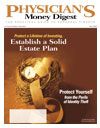Build Wealth for a Lifetime with Thrift
If you are looking for a magical formula to getrich, this article will disappoint you. If you arelooking for a glamorous investment, this articlewill terribly disappoint you. If you appreciate commonsensepractical advice that is almost guaranteedto build wealth, then read on.
Investing is a three-step process. First you mustmake money. Then you must not spend it. Only thendo you have money to invest. It is only through thriftthat you will ever have any capital for investment.Therefore, the most important factor in buildingwealth is thrift.
Save to Invest More
Thrift is the variable over which you have themost control. You could try to increase your incometo generate more investment capital. In a practicalsense, unless you change jobs or accept a significantchange in your lifestyle (eg, see more patients or takemore calls), it would be difficult or impossible toincrease your income. You can increase your wealthby increasing the return on your investment. Thisshould certainly be one of your long-term goals, butit requires very hard work over several years.
The best investors are the best savers. Say a physiciansaves and then invests $15,000. They receive a10% return and have $16,500 at the end of the firstyear. Say another physician is less thrifty with theirmoney and saves only $10,000, but hits an investmentgrand slam and realizes a 25% return. At theend of the first year, they have $12,500. It is almostimpossible for even world-class investing to overcomepoor saving habits.
How much should you save? Until recently, theaverage American saved 10% of their income. I thinka physician-in-training should save 20%, with thegoal of having a 20% down payment for a home.An established physician making a solid six-figureincome should be able to save at least one third,preferably one half, of their after-tax income. I did it,so I know it is possible.
Ignore Social Pressure
How much you spend can be changed both drasticallyand instantaneously. You can spend less—muchless—starting right now, today. Yet arrogance and egoare in constant conflict with thrift. An especially vulnerabletime in a physician's financial life is when theycomplete training and go into practice. Income canquadruple in an instant. Things that were previouslyonly a dream suddenly become a necessity.
This situation can be further complicated bysocial pressure. Some people feel that a physicianshould live in a home, drive a car, and wear a suit orwatch commensurate with their status and position.I prefer to impress people with my character, myaccomplishments, or my charitable donations ratherthan the home I live in or the car I drive. Are peoplewho judge you only by how you dress really worthyof your respect?
If there is only one lesson you learn here, I suggestthe following. If you can say, "This is too expensive,I cannot afford this," you have taken the first steptoward a lifetime of financial security.
Robert M. Doroghazi, MD, FACC, graduated from the University of
Chicago, Ptizker School of Medicine, and completed his medical
internship and residency at the Massachusetts General Hospital.
He retired last year after 23 years of practice with the Missouri
Cardiovascular Specialists in Columbia, Mo. He authored The
Physician's Guide to Investing, A Practical Approach to Building Wealth (Humana
Press; 2005). This book can be purchased at www.humanapress.com. Many of
the themes for this article are taken from the work of James Turk, who writes for
the Freemarket Gold & Money Report.
